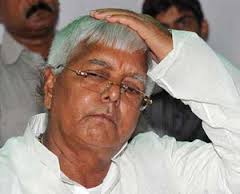Patna, Feb 24: Lalu Prasad's RJD in Bihar today split with 13 of the 22 legislators of the party pledging support to the Nitish Kumar government.
The 13, including five belonging to the minority community met at the residence of party MLA Samrat Chaudhary and wrote a letter to Speaker Uday Narayan Chaudhary withdrawing allegiance from the RJD and expressing support to the Nitish Kumar government.
RJD MLA Javed Iqbal Ansari confirmed to PTI that 13 party MLAs wrote to the Speaker withdrawing their allegiance from the RJD and expressing support to the JD(U) government of Nitish Kumar.
The RJD MLAs who walked out were Samrat Chaudhary, Raghvendra Pratap Singh, Durga Prasad Singh, Lalit Yadav, Anirudh Kumar, Jeetendra Rai, Akhtar-ul-Islam Sahin, Akhtar-ul-Iman, Abdul Gafood, Faiyazz, Javed Iqbal Ansari, Ram Lakhan Ram Raman and Chandrasekhar.
Samrat Chaudhary, the son of senior RJD leader Shakuni Chaudhary, alleged that Lalu Prasad had turned his party into the 'B team' of Congress in the last three months.
"The party which send him to jail by tearing up an ordinance has become the ideal of Lalu Prasad who is losing no opportunity to pester its leaders," Chaudhary told reporters.
Chaudhary who flew with the chief minister in a helicopter to Khagaria yesterday to inaugurate a road bridge said, "It will be better for Lalu Prasad to merge the party with Congress instead of allying with it for the Lok Sabha elections.
When pointed out that Lalu Prasad had sided with the Congress earlier also and asked the reason for leaving the party now, Samrat Chaudhary said the situation was different now.
Javed Ibbal Ansari, RJD MLA from Banka, praised the chief minister. "By severing ties with BJP, Kumar has shown his commitment to fight a communal leader like Narendra Modi."
Asked which party they would join, Ansari said "Obviously JD(U) to strengthen the hands of Nitish Kumar to fight communal forces."
With support of the 13 RJD MLAs the strength of Nitish Kumar government will go up to 128 in the 238-member House, surpassing the magic figure of 122.
JD(U) has 116 MLAs at present including Speaker Uday Narayan Chaudhary. It had support of four Congress MLAs, four Independents and one CPI MLA in the trust vote the Nitish government faced on June 19 last year after split in the NDA.






Comments
Add new comment